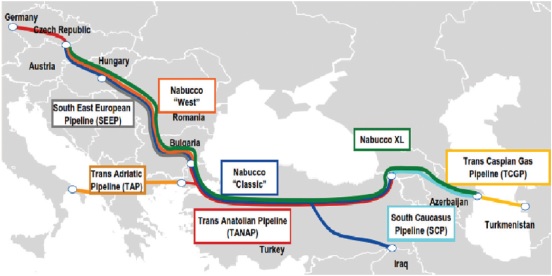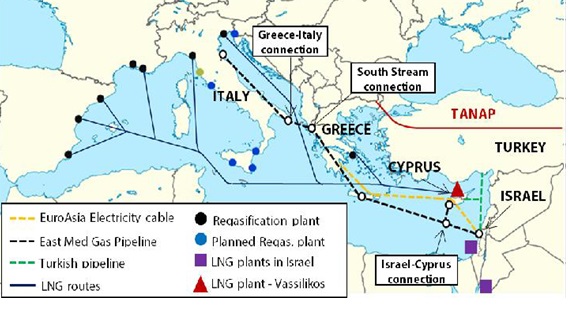GREAT THINGS HAVE SMALL BEGINNINGS: THE STRATEGIC SIMILARITIES OF THE SOUTHERN GAS CORRIDOR TO THE EARLY STAGES OF EAST MED CORRIDOR
 |
Dr. Theodoros Tsakiris, Assistant Professor for Energy Geopolitics, University of Nicosia, Head ELIAMEP Energy Programme |
On 17 May 2016, a ceremony took place in Thessaloniki that commemorated the beginning of the construction of the Trans Adriatic Pipeline (TAP) project. TAP, that crosses 545 km of Greek territory from Western Thrace to Western Macedonia, constitutes the final leg of a 4.000km system of pipelines, which inaugurates the EU’s Southern Gas Corridor Strategy.
Although the initial transit capacity of TAP is limited to 10 bcm/y, it is the first time that a post-Soviet gas source is linked to Europe in ways that bypasses Russia’s pipeline network. In that sense TAP offers simultaneous diversification of supply sources and routes, enhancing the EU’s gas security at a time of increasing net import dependency and growing doubt over the ability of the EU to emulate America’s share gas revolution.
This pipeline and the potential doubling of its capacity to 20 bcm/y by the mid-2020s opens up the way for the importation of more gas from the East whether it may be Iranian, Iraqi or Turkmen gas, although the principal owners of both TANAP and TAP, BP and SOCAR, are more likely to focus on the yet untapped potential of other major offshore fields located in the Azeri Exclusive Economic Zone (EEZ).
When the Shah Deniz field, the “feeder” of the Southern Corridor was discovered in 1999 many observers doubted the feasibility of the project and the pipeline system (Nabucco) that was proposed in 2002 as the main evacuation option for Azeri gas to Europe.
The region was too volatile and the project’s political risk significant. Azeri sovereignty over parts of its hydrocarbon wealth was actively challenged by both Iran and Turkmenistan that had competing claims over Azerbaijan’s EEZ. The pipeline had to cross through areas that were very close to active lines of confrontation such as the one between Azerbaijan and Armenia that recently flared up again in April 2016 and the one between Russia and Georgia that led to an all-out war in August 2008.
Regional geopolitical developments also heavily impacted the feasibility of competing pipeline projects as US and EU pressure forced the developers of both the Nabucco and TAP projects to cancel their plans for importing almost 50% of their throughput capacity from Iran.
By June 2013, when the Shah Deniz consortium selected TAP, the realization in EU policy circles of the emergence of a new region that could also play an important role in the Union’s diversification strategy was still at an early stage. Many observers doubted the potential importance of the region approximately along the same lines used for the Southern Corridor, despite the fact that the East Med is far less volatile than the Caspian Sea of the late 1990s or for that matter the 2000s.
Despite the geopolitical perturbations caused by the Arab Spring and Mr. Erdogan’s neo-ottoman revisionism that has systematically pitted him against Israel, Egypt, Greece and Cyprus, the basic regional security architecture established by the Camp David Accords of 1978. After 2013 there is a new strategic understanding and close cooperation between Israel and President al-Sissi that also extends to Jordan.
None of the EEZ accords signed in the region between Cyprus, Israel and Egypt (2003-2010) are questioned by anyone else other than Turkey and to a secondary extent Lebanon which is claiming only a small area of 854km2 that has had and is unlikely to have any negative impact on the development of Israeli gas resources from the Leviathan and Tamar fields.
Furthermore, Turkey’s attempts to force Cyprus to freeze its offshore exploratory program and scare away the IOCs (International Oil Companies) from participating in the development of Cypriot hydrocarbons, have been met with considerable disappointment.
In spite of a series of dry holes drilled in 2014-2015 by ENI-Kogas, the discovery of Zhor in the Egyptian Shorouk block located less than 5 nautical miles from the Cypriot EEZ, has re-galvanized the interest of the IOCs in Cyprus. Total is planning to drill an exploratory well in Block 11 and has bitterly regretted its decision to relinquish (February 2015) its exploration rights over Block 10.
ENI which renewed its exploratory license in December 2015 will drill at least two new exploration wells in Blocks 2 and 3 according to its 2013 contractual obligations and Shell -through its merger with BG- is currently leading the development of the Aphrodite gas field after buying 35% of the consortium’s share in January 2016.
Moreover, Nicosia, emboldened by Egypt’s recent success and the deepening strategic relationship between Cyprus, Egypt and Greece, has tendered off three more additional blocks in its EEZ by announcing a 3d Licensing Round on 23 March 2016. These blocks include blocks 6, 8 and 10 but more blocks are expected to be offered in 2016 or 2017 including parts of Block 11 that has been partially relinquished by Total in the context of its license renewal.
In addition to parts of Block 11 almost all of Block 12 will also become available for a tender with the exception of a small area demarcating the Aphrodite field. The exploration license of the Aphrodite shareholders is set to expire on 31/05/2016 and it is almost legally impossible to renew.
The prospective export of Aphrodite’s gas, estimated at approximately 7,4 bcm/y over 15 years to Shell’s underutilized Idku LNG plant will reactivate the facility and allow East Med gas to reach European markets by 2020-20201. These LNG volumes, part of which will be sold to the EU, will represent the first exports of Cypriot gas arriving in EU markets a mere decade after Aphrodite’s initial discovery in 2011.
Comparatively, the first Shah Deniz exports to reach Europe will arrive 21 years after the field’s discovery in 1999. But this is the beginning, not the end of the story as the Eastern Med and in particular its Levantine and Nile Basins hold the possibility of drastically increasing the EU’s import diversification by capitalizing on the potential of a Member-State and the developing infrastructure that will interconnect Israel-Cyprus and Egypt.
The European Commission is actively supporting through the Connect Europe Facility (CEF) the feasibility studies of two major Project of Common Interest (PCI) that could extend this regional energy infrastructure to Greece and/or Italy thereby transforming these projects into a new East Med Corridor independent of the Turkish Natural Gas System that is already vital for the implementation of the Southern Gas Corridor.
These two projects, the East Med Gas Pipeline and the EuroAsia Electricity Interconnector, as well as the more mature Vassilikos LNG option, would also seriously enhance Europe’s diversification of import routes but are still at a very early stage, much like the stage Nabucco and the ITGI projects were in, in the early 2000s.
In order for these projects to materialize, we first need to discover new fields in the wider East Med region while also promoting optimal regulatory and market opening practices that will reduce subsidies, improve efficiencies and increase the net export capacities of countries such as Egypt and Israel.
Moreover, the EU needs to engage in preventive diplomacy in the region by facilitating the dialogue between Israel and Lebanon and more importantly, by actively supporting the intercommunal talks on the resolution of the Cyprus Question in ways that would make sure that the basic liberties and principles of the EU acquis are fully integrated as part and parcel of any reunification plan without any permanent derogations as Ankara demands.
Finally, the EU needs to fully and actively support the RoC’s efforts to exercise its sovereign rights over its entire EEZ. This is no longer only an issue of moral solidarity based on the spirit and the letter of the Lisbon Treaty. It is rapidly becoming an issue of geostrategic compatibility governed by realpolitik.
To download this article (pdf format) click here


